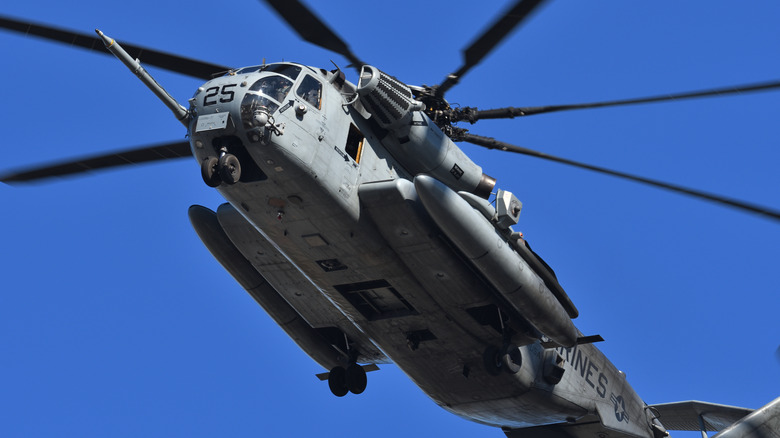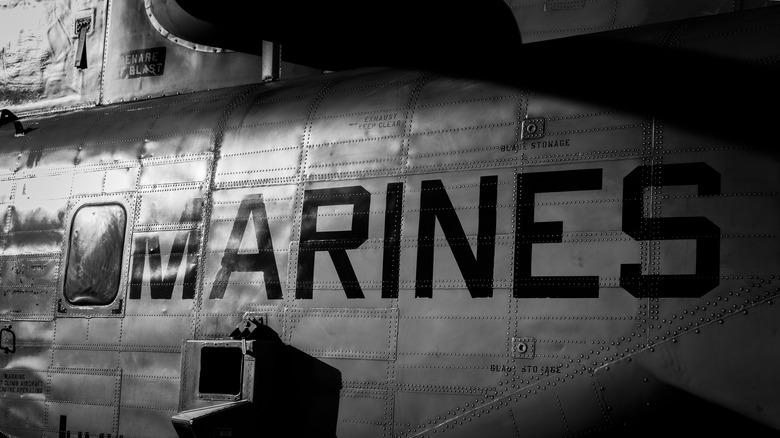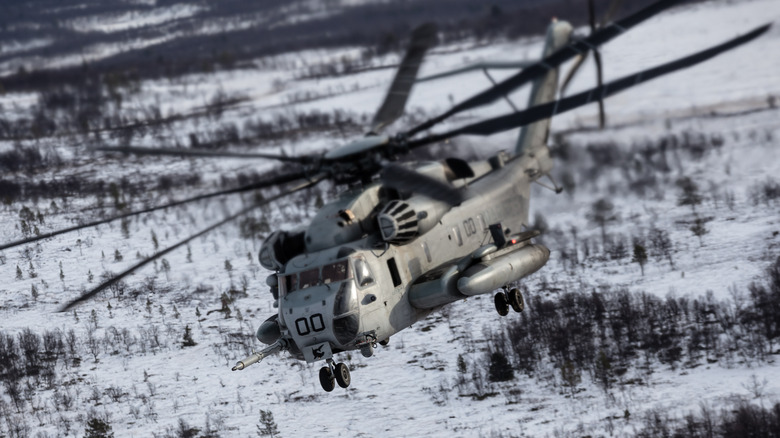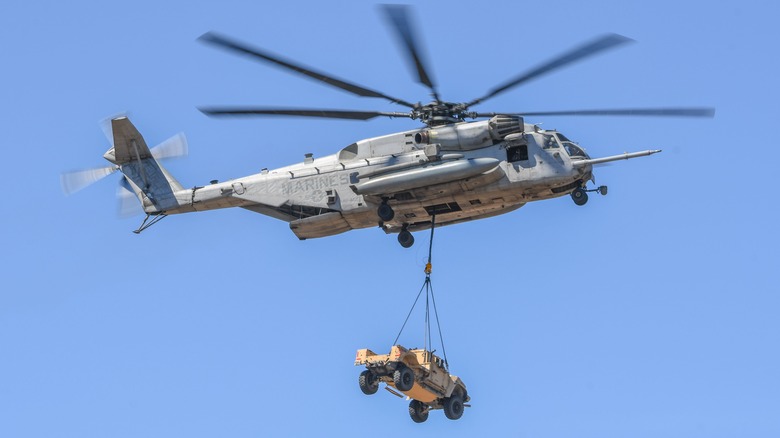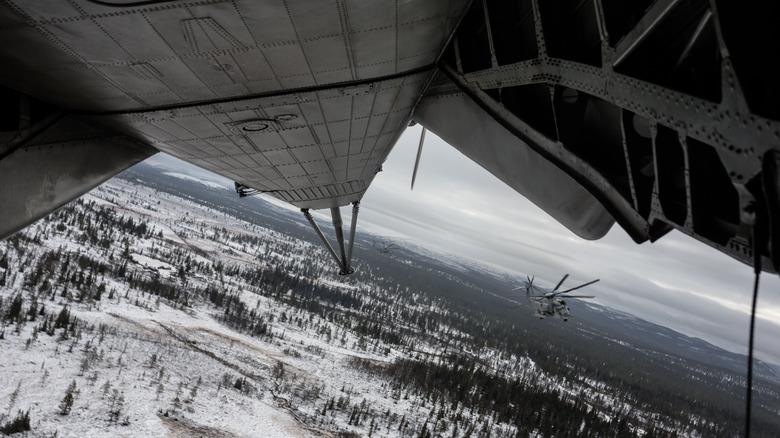Why The Legendary Sea Stallion Helicopter Has Such A High Accident Rate
It's difficult to say whether airplane or helicopter flight is "safer." After all, there are so many variables. An airplane crash has the potential to be far deadlier, as commercial flights tend to be carrying far more people than a typical helicopter. The latter, however, has typically fewer options to avert disaster. As Col. Lee Ellis, formerly of the Air Force, put it to Newsweek in March 2023: "In plane scenarios, an airplane with wings can glide several miles with an opportunity to crash land more safely."
Ellis also discussed the two tragic Black Hawk crashes that occurred that month at Fort Campbell: "military helicopters generally have riskier missions flying closer to the ground. It's always tragic to hear of the loss of our warriors." And one military helicopter that is noted for its high accident rate is the Sea Stallion, nearly as iconic as the Black Hawk.
It seems that development and training practices alike have played a part in the chopper's tragic reputation. Let's take a look at the history of the aircraft and how it has been tarnished by tragedy.
The creation and operational history of the Sea Stallion
As with so much military hardware, the Sea Stallion was the result of a request from the Department of Defense, which had noticed a hole that needed filling. In this case, the early 1960s marked a time when the Pentagon needed to replace Sikorsky's S-56, and the Bureau of Naval Weapons laid out its requirements for one such aircraft in March 1962. As Sikorsky details: "a ship based helicopter able to lift an 8,000 pounds (3630 kg) payload over a radius of 100 nm (115 miles, 185 km) at a speed of 150 knots (172 mph, 278 km/h)."
The resulting helicopter (after the Ling Tempco Vought that was initially selected for the role was deemed unfitting) was another Sikorsky model, the S-65, known also as the CH-53 Sea Stallion. It made its debut in the skies in October 1964, and served throughout the Vietnam War. Able to transport two-dozen stretchers, up to 38 infantrymen and their equipment, or the heaviest equipment like a Howitzer (depending on how the aircraft was set up), its General Electric turboshafts could propel it at 125 mph, at a weight of 50,000 pounds and a range of 540 nautical miles.
In 1972, the variant RH-53D was first used, and the YCH-53E's trials followed in 1974. These more advanced versions of the Stallion expanded into roles such as clearing mines. Despite its cache, though, the Stallion's history is marred by tragic accidents.
The accidents at the heart of the Stallion's history
By May of 1986, the Super Stallion CH-53E was, in the words of the Los Angeles Times, "the military's largest and most powerful helicopter." This certainly isn't a bad reputation from Sikorsky's point of view, but as its long line had developed, it had become known for a tragic string of accidents too. That very May, the newspaper notes, Congress launched an investigation into a half dozen crashes of the Super Stallion. At that time, a total of 21 Stallion accidents occurred since 1969, of which "nine were attributed to mechanical problems."
The Stallions seem to be subject to such problems rather more often than the typical military aircraft. More than twice as often, in fact. The Naval Safety Center defines a vehicle's rate of serious mishaps as the number of incidents of damage worth $1 million or more, or a fatality (/fatalities), for every 100,000 hours in the air. A typical rate for aircraft of this type is 2.26, but the Sea Dragon variant of the Stallion had a rate of 5.96.
The Sea Dragon in particular has the perilous job of aerial mine countermeasures, and with its formidable size, can carry 55 troops and 32,000 pounds of equipment. It's possible the hefty loads Sea Stallions must carry have contributed towards these accidents, past investigations have concluded.
What have investigations concluded about some Sea Stallion accidents?
Such problems are potentially reflected in the circumstances of a June 1984 crash, for example, which saw the deaths of four people on board near San Clemente. The Los Angeles Times reported that an inquiry found the large vehicle the Stallion was transporting started to break apart, causing structural damage to the helicopter. This would ultimately, horrifically, tear it apart. Analysis of the large vehicle being towed prior to the mission, the newspaper stated, "didn't take into account the Marine Corps' specialized lifting requirements."
Similarly, pilots were not sufficiently instructed on how to right the aircraft, with the Times noting there were "poorly written and ambiguous" instruction in this key area. Sadly, human error, so often fatal, has been a large factor in Sea Stallion disasters. In January 2016, everybody on board two Super Stallions was killed when the aircraft flew into each other near Oahu. A statement issued by the U.S. Marine Corps that October, CNN reports, noted that "low aircraft readiness leading to inadequate pilot proficiency, human factors and the squadron's lack of focus on basic aviation practices" contributed heavily to the tragedy.
The issue, however, has roots far beyond this one incident. A Marine Corps report in the wake of the tragedy revealed that some Sea Stallion pilots felt that they weren't getting the regular flying hours they needed, and thus their training was insufficient and they could be more prone to deadly errors.
Human and mechanical factors combine
Marine Corps Times reported at the time that issues such as these were "endemic to Marine Corps aviation — especially the troubled CH-53E fleet." Why was the fleet – and by extension, the Sea Stallion – particularly troubled? The family had been subjected to more of a gradual overhaul than a substantial ground-up rebuilding as it went on, potentially suggesting that components were becoming difficult to maintain and replace. This, in turn, may have been a factor in mechanical failures that caused accidents.
At the onset of the 1986 investigations, the Los Angeles Times quoted Congressman Robert Badham as saying that he received "very heavy assurances" that concerns he had surfaced previously about technical issues of the aircraft had been "isolated and fixed." This would indicate that there were known issues with the Sea Stallions, and that, if not diligently dealt with, may have followed them throughout their careers. In 2015, a Super Stallion's engine failed during a landing, causing it to fall into the ocean rather than landing on its target ship, the Mesa Verde. Engine number two, which caused the incident, had done the very same thing during a training flight shortly before.
The Sea Stallion family remain long-serving helicopters that have performed a range of vital roles for the military, much like the Huey. Sadly, though, it has a checkered past, marked by tragedies.
